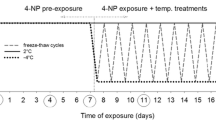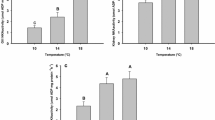Summary
Inorganic ions (Ca, Mg, Na, K, Cl, SO4) and free amino acids of the body fluids of the normal, cold and warm acclimated worms (laboratory as well as seasonal populations) are estimated. Calcium increased and chloride and sodium decreased on both cold and warm acclimation in relation to normal. But magnesium and sulphate and free amino acids increased on warm acclimation whereas potassium increased and magnesium decreased on cold acclimation. Changes in different ions in the same direction are observed in the seasonal populations. Attention is drawn to the adaptive significance of these changes in the different ions during thermal acclimation.
Changes in the glycogen, RNA, protein and non-protein nitrogen, and water content in the tissues of normal and acclimated worms are studied. Glycogen increased on warm and cold acclimation, whereas RNA content, protein nitrogen and dry weight of the cold worms increased over normal. No change is observed in non-protein nitrogen on thermal acclimation. The role of these substances and the significance of the changes observed, in the operation of homeostatic mechanism compensating to temperature changes in the metabolic rate of the worms, are also discussed.
Changes in the pattern of neurosecretory activity are followed with thermal acclimation and it is shown that the activity of the neurosecretory cells increased on cold and warm acclimation, but the positions of these cells, which are active, are different from normal worms in warm acclimated worms.
Studies on the effect of the body fluids of acclimated worms on the tissues of normal and acclimated worms showed that the body fluids of cold acclimated worms increased the respiration of the tissues of normal and warm acclimated worms and vice-versa.
Similar content being viewed by others
Literature
Bahl, K. N.: Excretion in the oligochaeta. Biol. Rev. 22, 109–147 (1947).
Brecher, L.: As cited by Prosser and Brown 1961 (1929).
Buddenbrock: As cited by Precht 1958 (1950).
Bullock, T. H.: Compensation for temperature in the metabolism and activity of poikilotherms. Biol. Rev. 30, 311–342 (1955).
Burma, D. P.: Oxidative and reductive pentose phosphate pathways. Ann. Biochem. 20, 97–102 (1960).
Cohn, C., and D. Joseph: Effect of rate of ingestion of diet on HMP shunt activity. Amer. J. Physiol. 197 (6), 1347–1349 (1959).
Davis, J. E., E. Dacosta, and A. B. Hastings: As cited by Precht 1958 (1934).
Doudoroff, P.: The resistance and acclimatization of marine fishes to temperature changes. II. Experiments with Fundulus and Atherinops. Biol. Bull. 88, 194–206 (1945).
Drilhon-Courtois, A.: As cited by Prosser and Brown 1961 (1934).
Edelbacher, S., and F. Leuthardt: As cited by Precht 1958 (1955).
Ekberg, D. R.: Respiration in tissues of gold fish adapted to high and low temperatures. Biol. Bull. 114, 308–315 (1958).
Fisher, K. C.: An approach to the organ and cellular physiology of adaptation to temperature in fish and small mammals. In “Physiological Adaptation”, edit. by C. Ladd Prosser, pp. 3–49. Washington: American Physiological Society 1958.
Fruton, J. S., and S. Simmonds: General Biochemistry, p. 909. Madras: Asia Publishing House 1960.
Gilbert, A. B.: The composition of blood of the shore crab Carcinus moenas Pennat in relation to sex and size. I. Body fluid conductivity and freezing point depressions. J. exp. Biol. 36, 113–119 (1959).
Glock, G. E., and P. McLean: Levels of enzymes of the direct oxidative pathway in mammalian tissues and tumours. Biochem. J. 56, 171–175 (1954).
— —: A preliminary investigation of the hormonal control of the hexose monophosphate oxidative pathway. Biochem. J. 61, 390–397 (1955).
Gordon, M. S.: Ionic regulation in the brown trout (Salmo trutta L.). J. exp. Biol. 36, 227–252 (1959).
Grant, W. C.: Temperature tolerance in earthworms. Anat. Rec. 117, 561 (1953).
Gros, P., G. P. Talwar et J. Coursaget: Bull. Soc. Chim. biol. (Paris) 36, 1569 (1954). Quoted by Knox 1958.
Haarmann, W.: As cited by Precht 1958 (1954).
Habibulla, Md.: Studies on the neurosecretion of a selected arachnid, Heterometrus swammerdami. Doctoral dissertation submitted to the Sri Venkateswara University, Tirupati 1962.
Halsbad, E. Z.: As cited by Fisher 1958 (1953).
Hawk, P. B., B. L. Oser, and W. H. Summerson: Practical Physiological Chemistry New York: McGraw-Hill Book Co. 1954.
Hoar, W. S., and M. K. Cottle: Some effects of temperature acclimation on the chemical constitution of goldfish tissues. Canad. J. Zool. 30, 49–54 (1952).
Isoyama, K.: On the mechanism of hyperglycemia induced by cold. J. Physiol. Soc. Japan 22, 193–196 (1960).
Jankowski, H.D.: Über die hormonale Beeinflussung der Temperaturadaptation beim Grasfrosch (Rana temporaria). Z. vergl. Physiol. 43, 392–410 (1960).
Kanungo, M. S., and C. L. Prosser: Physiological and biochemical adaptation of goldfish to cold and warm temperatures. II. Oxygen consumption of liver homogenate. Phosphorylation of liver mitochondria. J. cell. comp. Physiol. 54, 265–274 (1959).
Kaplan, H. M., and G. T. Crouse: Blood changes underlying the seasonal resistance of frogs to disease. Copeia 1, 52–54 (1956).
Knox, W. E., V. H. Auerbach, and E. C. C. Lin: As cited by Fisher 1958 (1956).
- - -Adaptive enzymes in the regulation of animal metabolism. In: Physiological Adaptation, ed. by Prosser 1958.
Marapao, D.P.P.: The effect of nervous tissue extracts on neurosecretion in the earthworm Lumbricus terrestris. Catholic U. Amer. Biol. Stad. 55, 1–34 (1959).
Meyer, D. K., B. A. Westfall, and W. S. Planter: As cited by Fisher 1958 (1956).
Milton, R. F., and W. A. Waters: Methods of Quantitative Micro-analysis. London: Edward Arnold Ltd. 1955.
Padmanabhanaidu, B., and R. Ramamurthy: The influence of sex and size on the osmotic pressure, the chloride and the free amino acids of the blood of the freshwater field crab Paratelphusa sp. and the freshwater mussel Lamellidens marginalis. J. exp. Biol. 38, 35–41 (1961).
Pampapathi Rao, K.: Metabolism of tropical poikilotherms with special reference to temperature acclimation. Proceedings of the summer school, Simla 1961.
—: Physiology of acclimation to low temperature in poikilotherms. Science 137, 682–683 (1962).
—: Physiology of low temperature acclimation in tropical poikilotherms. I. Ionic changes in the blood of the freshwater mussel, Lamellidens marginalis and the earthworm, Lampito mauritii. Proc. Indian Acad. Sci. B 57 (5), 290–296 (1963a).
—: Physiology of low temperature acclimation in tropical poikilotherms. II. Interferometric analysis of the protein content of blood cells in the freshwater mussel Lamellidens marginalis, and the earthworm Lampito mauritii. Proc. Indian Acad. Sci. B 57 (5), 297–299 (1963b).
—: Physiology of low temperature acclimation in tropical poikilotherms. IV. Quantitative changes in the nucleic acid content of the tissues of the freshwater mussel, Lamellidens marginalis. Proc. Indian Acad. Sci. B 58 (1), 11–13 (1963c).
- Some biochemical mechanisms of low temperature acclimation in tropical poikilotherms. In: International Symposium on “The role of cellular reactions in adaptation of multicellular poikilotherms to the environmental temperature”. Leningrad 1963d.
—, and R. Ramachandra: Effect of acclimatization to high temperature on the blood chloride, free amino acids and osmotic pressure in the freshwater field crab Paratelphusa sp. and the freshwater mussel, Lamellidens marginalis. J. exp. Biol. 38, 29–34 (1961).
—, and K. Saroja: Physiology of low temperature acclimation in tropical poikilotherms. V. Changes in the activity of neurosecretory cells in the earthworm, Lampito mauritii, and evidence for a humoral agent influencing metabolism. Proc. Indian Acad. Sci. 58, 14–18 (1963).
—, and V. Venkata Reddy: Compensation to high temperature in the loss and active absorption of chloride in the freshwater field crab, Paratelphusa sp. Comp. Biochem. Physiol. 5, 65–67 (1962).
Precht, H. J.: Concepts of the temperature adaptation of unchanging reaction systems of cold blooded animals. In: Physiological adaptation, C.L. Prosser, Ed., p. 50–78. Washington, D. C.: The American Physiological Society Inc. 1958.
—: J. Christophersen, and H. Hensel: Temperatur und Leben. Berlin-Göttingen-Heidelberg: Springer 1955.
Prosser, C. L. (Ed.): Physiological adaptation. Washington, D.C.: Physiological Society, Inc. 1958.
-, and F. A. Brown: Comparative animal physiology. W. B. Saunders Co. 1961.
Raghupathiramireddy, S., and K. Pampapathi Rao: Physiology of low temperature acclimation in tropical poikilotherms. III. Quantitative changes in the bound and free amino acids in the earthworm, Lampito mauritii. Proc. Indian Acad. Sci. 58, 1–10 (1963).
Ramsay, J. A.: The osmotic relations of the earthworm. J. exp. Biol. 26, 46–55 (1949).
Robertson, J. D.: Further studies on ionic regulation in marine invertebrates. J. exp. Biol. 30, 277–296 (1953).
-Ionic regulation by invertebrates. In: Physiology of invertebrate animals, ed. B. T. Scheer, p. 229–246. University of Oregon Press 1957.
—, and D. A. Webb: The microestimation of sodium, potassium, calcium, magnesium, chloride and sulfate in sea water and body fluids of marine animals. J. exp. Biol. 16, 155–177 (1939).
Saroja, K.: Studies on the oxygen consumption in earthworms with special reference to thermal acclimation. Doctoral dissertation submitted to the Sri Venkateswara University, Tirupati 1962.
Schlicher, J.: Vergleichend physiologische Untersuchungen der Blutkörperchenzahlen bei Knochenfischen. Zool. Jb., Abt. allg. Zool. Physiol. 43, 122 (1926).
Selvarajan, V. R.: Chloride regulation in a freshwater fish, Cirrhina reba, under heterosmotic conditions and high temperature. Proc. Indian Acad. Sci. B 55, 91–98 (1962).
Smillie, R. M., and G. Krotkov: The estimation of nucleic acids in some algae and higher plants. Canad. J. Bot. 38, 31–49 (1960).
Spoor, W. A.: Temperature and erythrocyte count of the goldfish. Fed. Proc. 10, 131 (1951).
Srikantan, T. N., and C. R. Krishnamurti: Tetrazolium test for dehydrogenases. J. Sci. Ind. Research 14C, 206–209 (1955).
Stanier, R. U.: The synthesis of enzymes. In: Outlines of Enzyme Chemistry by J. B. Neilands and K. Paul Stumpf. New York: John Wiley & Sons 1955.
Stolkowski, J., and A. Reinberg: Studies on the mechanism of action of certain corticosteroid hormones on cellular potassium. 1. The effect of glucose and ATP on the movement of cellular potassium. Ann. Endocr. (Paris) 17, 137–139 (1956).
— — and F. Blanc-Dingeon: Effect of temperature on the movements of potassium and on the polymerization of ribonucleic acids in the isolated surviving hearts of Helix aspersa. J. Physiol. (Paris) 52, 228–229 (1960).
Straub, M.: As cited by Precht 1958 (1957).
Suhrman, R.: Weitere Versuche über die Temperaturadaptation der Karauschen (Carassius vulgaris). Biol. Zbl. 74, 432–448 (1955).
Tilgner-Peter, A.: Jahreszeitliche und klimatische Schwankungen im Calcium-und Phosphat-Gehalt des Blutes von Helix pomatia. Zool. Jb., Abt. allg. Zool. Physiol. 67, 365–372 (1959).
Umbreit, W. W., R. H. Burris, and J. F. Stauffer: Manometric techniques. Minneapolis: Burgess Publ. Co. 1959.
Welsh, J. H., and R. I. Smith: Laboratory Exercises in invertebrate physiology. Minneapolis: Burgess Publ. Co. 1960.
Wigglesworth, V. B.: The control of growth and form: A study of the epidermal cell in an insect. New York: Cornell University Press 1961.
Yielding, K. L., and G. M. Tomkins: Inhibition of the enzymic oxidation of DPNH by steroid hormones. Proc. nat. Acad. Sci. (Wash.) 45, 1730–1739 (1959).
Author information
Authors and Affiliations
Rights and permissions
About this article
Cite this article
Saroja, K., Pampapathi Rao, K. Some aspects of the mechanism of thermal acclimation in the earthworm Lampito mauritii . Zeitschrift für vergleichende Physiologie 50, 35–54 (1965). https://doi.org/10.1007/BF00388051
Received:
Issue Date:
DOI: https://doi.org/10.1007/BF00388051




